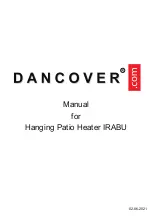
4
OPERATION OF THESE FANS CAN PRODUCE A NEGATIVE
DRAFT IN THE AREA OF THE WATER HEATER PREVENTING
THE PRODUCTS OF COMBUSTION FROM EXHAUSTING
THROUGH THE CHIMNEY OR VENT PIPE.
The venting of the water heater should be inspected by a qualified
service technician at the time of installation and periodically
thereafter to ensure a down-draft condition does not exist.
DO NOT OBSTRUCT THE FLOW OF COMBUSTION AND
VENTILATING AIR. ADEQUATE AIR FOR COMBUSTION AND
VENTILATION MUST BE PROVIDED FOR SAFE OPERATION.
EXTENDED NON-USE PERIODS
WARNING
HYDROGEN GAS CAN BE PRODUCED IN A HOT WATER
SYSTEM SERVED BY THIS HEATER THAT HAS NOT BEEN
USED FOR A LONG PERIOD OF TIME (GENERALLY TWO
WEEKS OR MORE). HYDROGEN GAS IS EXTREMELY
FLAMMABLE.
To reduce the risk of injury under these conditions,
it is recommended that the hot water faucet be opened for several
minutes at the kitchen sink before using any electrical appliance
connected to the hot water system. If hydrogen is present, there will
probably be an unusual sound such as air escaping through the pipe
as the water begins to flow.
THERE SHOULD BE NO SMOKING
OR OPEN FLAME NEAR THE FAUCET AT THE TIME IT IS OPEN.
INSULATION BLANKETS
Insulation blankets available to the general public for external
use on gas water heaters are not approved for use on your
Lochinvar water heater. The purpose of an insulation blanket is to
reduce the standby heat loss encountered with storage tank water
heaters. Your Lochinvar water heater meets or exceeds the the
current edition of ASHRAE/IES 90.1 standards with respect to
insulation and standby loss requirement making an insulation
blanket unnecessary.
WARNING
Should you choose to apply an insulation blanket to this
heater, you should follow these instructions. Failure to follow
these instructions can result in fire, asphyxiation, serious
personal injury or death.
•
Do not apply insulation to the top of the water heater, as
this will interfere with safe operation of drafthood.
•
Do not cover the temperature & pressure relief valve.
•
Do not cover the instruction manual. Keep it on the side
of the water heater or nearby for future reference.
•
Do obtain new labels from Lochinvar for placement on the
blanket directly over the existing labels.
HIGH ALTITUDE INSTALLATIONS
WARNING
INSTALLATIONS ABOVE 2000 FEET (610 METERS) REQUIRE
REPLACEMENT OF THE BURNER ORIFICE IN ACCORDANCE
WITH SECTION 8.1.2 OF THE NATIONAL FUEL GAS CODE
(ANSI Z223.1). FAILURE TO REPLACE THE ORIFICE WILL
RESULT IN IMPROPER AND INEFFICIENT OPERATION
OF THE APPLIANCE RESULTING IN THE PRODUCTION
OF INCREASED LEVELS OF CARBON MONOXIDE GAS
IN EXCESS OF SAFE LIMITS WHICH COULD RESULT IN
SERIOUS PERSONAL INJURY OR DEATH.
You should contact your gas supplier for any specific changes
which may be required in your area.
As elevation above sea level is increased, there is less oxygen
per cubic foot of air. Therefore, the heater input rate should be
reduced at high altitudes for satisfactory operation with the reduced
oxygen supply. Failure to make this reduction would result in an
overfiring of the heater causing sooting, poor combustion and/or
unsatisfactory heater performance.
REQUIREMENTS
Ratings specified by manufacturers for most appliances apply
for elevations up to 2000 feet. For elevations above 2000
feet, ratings must be reduced at the rate of 4% for each 1000
feet above sea level. For example, if a heater is rated at
120,000 Btuh at sea level, to rate the heater at 4000 feet, you
subtract 4 (once for each thousand feet) x.04 (4% input reduction)
x 120,000 Btuh (original rating) from the original rating. Therefore,
to calculate the input rating at 4,000 feet: 4 x .04 x 120,000 =19,200
Btuh, 120,000 - 19,200 = 100,800 Btuh. At 6000 feet the correct
input rating should be 91,200 Btuh.
The input reduction is primarily achieved by reducing the
size of the main burner orifices. To do this, the main burner
orifices require replacement with orifices sized for the particular
installation elevation. Correct orifice sizing and parts may be
obtained from
Lochinvar. When ordering, be sure to state the
model number and the altitude of the location where the water
heater is being installed.
Upon completion of derating of the heater, adjustment to the
gas pressure regulator may be required. See CHECKING
THE INPUT section in this manual for inlet and manifold
pressure requirements.
Also due to the input rating reduction required at high altitudes,
the output rating of the appliance is also reduced and should be
compensated for in the sizing of the equipment for application.
FEATURES
THE ELIMINATOR™
(SELF-CLEANING SYSTEM)
These units include The Eliminator (Self-Cleaning System)
installed in the front water inlet, see Figure 2. The Eliminator
must be oriented correctly for proper function. There is a marked
range on the pipe nipple portion of the Eliminator, that must be
aligned with the top of the inlet spud. A label above the jacket
hole has an arrow that will point to the marked portion of the pipe
nipple if the orientation is correct. If the arrow does not point
within the marked range on the pipe nipple, adjust the pipe nipple
to correct. A pipe union is supplied with the Eliminator to reduce
the probability of misaligning the Eliminator accidentally while
tightening the connection to the inlet water supply line. Improper
orientation of the Eliminator can cause poor performance of the
heater and can significantly reduce outlet water temperatures
during heavy draws.
Note: The inlet tube may have 1, 3 or 7 cross tubes.
FIGURE 2
For proper function, the Eliminator must be oriented correctly.
There is a marked range on the pipe nipple that must be aligned
with the top of the inlet spud (check for label on the appliance)
to assure proper operation. Please check to confirm that the
marked range is in alignment with the top of the spud. A pipe
union is supplied with the Eliminator to help eliminate the





































